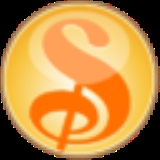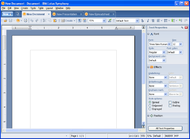
IBM Lotus Symphony
Encyclopedia
Software suite
A software suite or application suite is a collection of computer programs, usually application software and programming software of related functionality, often sharing a more-or-less common user interface and some ability to smoothly exchange data with each other.Sometimes software makers...
for creating, editing, and sharing text, spreadsheet, presentations and other documents, and is currently distributed as freeware
Freeware
Freeware is computer software that is available for use at no cost or for an optional fee, but usually with one or more restricted usage rights. Freeware is in contrast to commercial software, which is typically sold for profit, but might be distributed for a business or commercial purpose in the...
. First released in 2007, the suite has a name similar to the 1980s DOS
DOS
DOS, short for "Disk Operating System", is an acronym for several closely related operating systems that dominated the IBM PC compatible market between 1981 and 1995, or until about 2000 if one includes the partially DOS-based Microsoft Windows versions 95, 98, and Millennium Edition.Related...
suite Lotus Symphony, but the two programs are otherwise unrelated. The previous Lotus application suite, Lotus SmartSuite
Lotus SmartSuite
SmartSuite is an office suite from Lotus Software. The company made versions of its office suite for IBM OS/2 and Microsoft Windows.-Status:SmartSuite is in maintenance mode, and supported with fixes and fixpacks on Windows 2000 and Windows XP...
, is also unrelated.
Features
IBM Lotus Symphony consists of:- IBM Lotus Symphony Documents, a word processorWord processorA word processor is a computer application used for the production of any sort of printable material....
- IBM Lotus Symphony Spreadsheets, a spreadsheetSpreadsheetA spreadsheet is a computer application that simulates a paper accounting worksheet. It displays multiple cells usually in a two-dimensional matrix or grid consisting of rows and columns. Each cell contains alphanumeric text, numeric values or formulas...
program - IBM Lotus Symphony Presentations, a presentation programPresentation programA presentation program is a computer software package used to display information, normally in the form of a slide show...
Each application is split into tabs
Tab (GUI)
In the area of graphical user interfaces , a tabbed document interface is one that allows multiple documents to be contained within a single window, using tabs as a navigational widget for switching between sets of documents...
.
Symphony supports the OpenDocument
OpenDocument
The Open Document Format for Office Applications is an XML-based file format for representing electronic documents such as spreadsheets, charts, presentations and word processing documents....
formats as well as the binary Microsoft Office
Microsoft Office
Microsoft Office is a non-free commercial office suite of inter-related desktop applications, servers and services for the Microsoft Windows and Mac OS X operating systems, introduced by Microsoft in August 1, 1989. Initially a marketing term for a bundled set of applications, the first version of...
formats. It can also export Portable Document Format
Portable Document Format
Portable Document Format is an open standard for document exchange. This file format, created by Adobe Systems in 1993, is used for representing documents in a manner independent of application software, hardware, and operating systems....
(PDF) files and import Office Open XML files. Previous support for Lotus SmartSuite formats was disabled in Symphony 3.
Symphony is available for Linux
Linux
Linux is a Unix-like computer operating system assembled under the model of free and open source software development and distribution. The defining component of any Linux system is the Linux kernel, an operating system kernel first released October 5, 1991 by Linus Torvalds...
, Windows
Microsoft Windows
Microsoft Windows is a series of operating systems produced by Microsoft.Microsoft introduced an operating environment named Windows on November 20, 1985 as an add-on to MS-DOS in response to the growing interest in graphical user interfaces . Microsoft Windows came to dominate the world's personal...
, and Mac OS X
Mac OS X
Mac OS X is a series of Unix-based operating systems and graphical user interfaces developed, marketed, and sold by Apple Inc. Since 2002, has been included with all new Macintosh computer systems...
. It is based on Eclipse
Eclipse (software)
Eclipse is a multi-language software development environment comprising an integrated development environment and an extensible plug-in system...
Rich Client Platform
Rich Client Platform
A rich client platform is software consisting of the following components:* A core , lifecycle manager* A standard bundling framework* A portable widget toolkit* File buffers, text handling, text editors...
from IBM Lotus Expeditor
IBM Lotus Expeditor
IBM Lotus Expeditor is a software framework by IBM's Lotus Software division for the construction, integration, and deployment of "managed client applications", which are client applications that are deployed from, configured, and managed onto a desktop, usually by a remote server...
for its shell and OpenOffice.org
OpenOffice.org
OpenOffice.org, commonly known as OOo or OpenOffice, is an open-source application suite whose main components are for word processing, spreadsheets, presentations, graphics, and databases. OpenOffice is available for a number of different computer operating systems, is distributed as free software...
3 for the core office suite code. OpenOffice.org version 1.1.4 was dual-licensed under both the GNU Lesser General Public License
GNU Lesser General Public License
The GNU Lesser General Public License or LGPL is a free software license published by the Free Software Foundation . It was designed as a compromise between the strong-copyleft GNU General Public License or GPL and permissive licenses such as the BSD licenses and the MIT License...
and Sun's own SISSL
Sun Industry Standards Source License
The Sun Industry Standards Source License is now a retired free and open source license, recognized as such by the Free Software Foundation and the Open Source Initiative . Under SISSL, developers could modify and distribute source code and derived binaries freely. Furthermore, developers could...
, which allowed for entities to change the code without releasing their changes. Therefore, IBM does not have to release the source code of Symphony.
History
Symphony has its roots in IBM WorkplaceIBM Workplace
IBM Workplace was a brand of collaborative software applications from IBM's Lotus Software division. It was intended to be the next generation of collaboration software that would work with IBM's Java EE-based WebSphere Portal server software...
. In 2006, IBM introduced Workplace Managed Client version 2.6, which included "productivity tools" — a word processor, spreadsheet, and presentation program — that supported ODF. Later that year, IBM announced that Lotus Notes 8, which already incorporated Workplace technology, would also include the same productivity tools as the Workplace Managed Client. In 2007, IBM released Notes 8, and then released Notes' productivity tools as a standalone application, Symphony, in a beta one month later. The code in Symphony is the same as that for Notes 8's productivity tools.
IBM released version 1.0 of Lotus Symphony in May 2008 as a free download, and introduced three minor upgrades through 2008 and 2009. In 2010, IBM released version 3.0. It incorporated code from OpenOffice.org 3.x, and includes enhancements such as new sidebars
Sidebar (computing)
The sidebar is a term that is used for a GUI element that displays various forms of information to the side of an application or desktop user interface.-Widgets in sidebars:...
in its user interface and support for Visual Basic for Applications
Visual Basic for Applications
Visual Basic for Applications is an implementation of Microsoft's event-driven programming language Visual Basic 6 and its associated integrated development environment , which are built into most Microsoft Office applications...
macros, OpenDocument Format 1.2, and OLE
Object Linking and Embedding
Object Linking and Embedding is a technology developed by Microsoft that allows embedding and linking to documents and other objects. For developers, it brought OLE Control eXtension , a way to develop and use custom user interface elements...
. Symphony 3.0 was originally planned to include other existing OpenOffice.org modules, including an equation editor, database software, and a drawing program.
The software is developed by IBM China Development Laboratory, located in Beijing
Beijing
Beijing , also known as Peking , is the capital of the People's Republic of China and one of the most populous cities in the world, with a population of 19,612,368 as of 2010. The city is the country's political, cultural, and educational center, and home to the headquarters for most of China's...
. During the Lotusphere
Lotusphere
Lotusphere is an annual conference hosted by Lotus Software .Except for the first conference, which took place in December 1993, Lotusphere is held in late January. It starts with a reception party on Sunday night, and continuing on through the closing session on Thursday afternoon...
event in 2009, IBM confirmed its cost reduction effort using Lotus Symphony: the company is migrating its 400,000 users from Microsoft Office to Lotus Symphony. , IBM stated that Lotus Symphony has 12 million users.
On July 13, 2011, IBM announced that it would donate Lotus Symphony to the Apache Foundation.


Version release dates
Beta 1- Released on September 18, 2007
Beta 2
- Released on November 5, 2007
Beta 3
- Released on December 17, 2007
- Released in 23 languages on January 7, 2008
Beta 4
- Released on February 1, 2008. Introduced the Lotus Symphony Developer Toolkit.
- Revised edition released on March 3, 2008
Version 1.0
- Released on May 30, 2008
Version 1.1
- Released on August 29, 2008
Version 1.2
- Released on November 4, 2008
- Revised edition released on Feb 23, 2009
Version 1.3
- Released on June 10, 2009
- Revised edition released on September 1, 2009
Version 3 Beta
- Released on February 4, 2010
Version 3 Beta 2
- Released on February 4, 2010
Version 3 Beta 3
- Released on June 7, 2010
Version 3 Beta 4
- Released on August 26, 2010
Version 3.0
- Released October 21, 2010
Version 3.0 FixPack 1
- Released January 13, 2011
Version 3.0 FixPack 2
- Released April 20, 2011
Version 3.0 FixPack 3
- Released July 20, 2011
See also
- List of word processors
- Comparison of word processorsComparison of word processors-General information:This table provides general information about selected word processors.-Characteristics:This table gives characteristics of each word processor.-Operating System Compatibility:...
- Comparison of office suites
- OpenDocument softwareOpenDocument softwareThis is an overview of software support for the OpenDocument format, an open document file format for saving and exchanging editable office documents.-Current support:...
- Office Open XML softwareOffice Open XML softwareThis is an overview of software support for the Office Open XML format, a Microsoft document file format for saving and exchanging editable office documents.The list here is not exhaustive.-ECMA-376 1st edition implementations:...

